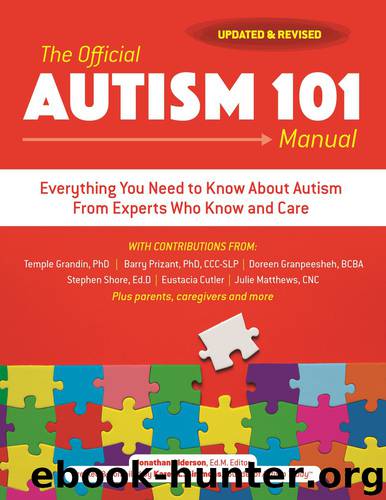The Official Autism 101 Manual by Karen L. Simmons

Author:Karen L. Simmons
Language: eng
Format: epub
ISBN: 9781510722552
Publisher: Skyhorse Publishing
Published: 2018-03-25T16:00:00+00:00
Generalization
Generalization refers to the ability of an individual to use a new skill in situations beyond the training session, and hopefully to use the new skill spontaneously without prompting from others. To achieve this level of fluidity with a new skill, individuals must practice and repeat the skill steps a great deal. As a result, it is unrealistic to think one can generalize many new skills at once. In my experience, true generalization occurs when individuals are reminded about or rehearse no more than one to three new skills every day for several months. Although individuals can learn the concept of many more skills during skill lessons, they may only be able to generalize one to three new skills at a given time. Generalization of a skill involves three steps: priming before the situation in which the skill is needed; frequent facilitated opportunities to practice the skill; and review of the skill after it is used.
Priming involves some reminder to the individual of what the skill steps are just prior to needing the skill. For example, just before going on a job interview, an individual might go over how to answer anticipated questions. Or just prior to starting a frustrating task at school or at work, the individual might review options for dealing with frustrating work. Priming can be verbal and/or supplemented by a visual aide. Verbal priming involves someone verbally explaining the skill steps prior to the situation in which they will be needed. Cue cards, behavior charts, copies of skill lessons (see Baker, 2003), Social Stories™, cognitive picture rehearsals, and social skill picture books can serve as visual aides that depict the skill steps.
If students want to change their behavior but can’t remember the skill steps, then cue cards or copies of the skill lessons may be ideal. We might write one to three skills on an index card and laminate it. Then we might ask a parent, teacher, or employer (or the students themselves) to review the skill steps prior to the situation in which it will be needed. Although it is ideal for the student to see the skill steps immediately prior to the situation in which they need to use the skill, this may not always be practical. Instead the parent, teacher, employer, or student might review the skill once in the morning prior to school or work, once at lunch, and then again at the end of the day so that the student at least has to think about the skill three times per day.
If a student has not fully agreed to try a new skill and thus is lacking in “internal” motivation to perform the skill, then a behavior chart can be used in which external rewards are contingent on demonstrating certain targeted skills.
In order to practice the new skills, students need opportunities. Facilitated opportunities involve creating daily situations in which the skills can be practiced and coached. Sometimes those opportunities are naturally built into the day. For example, a student learning to
Download
This site does not store any files on its server. We only index and link to content provided by other sites. Please contact the content providers to delete copyright contents if any and email us, we'll remove relevant links or contents immediately.
I Capture the Castle by Dodie Smith(1571)
Aspergirls by Rudy Simone(1360)
Be Different by John Elder Robison(1329)
Autism's False Prophets by Paul A. Offit(1238)
My Child's Different by Elaine Halligan(1228)
Smart but Scattered—and Stalled by Richard Guare(1193)
What's Making Our Children Sick? by Michelle Perro(1155)
101 Tips for the Parents of Boys with Autism by Ken Siri(1151)
Asperger Syndrome (Autism Spectrum Disorder) and Long-Term Relationships by Ashley Stanford(1111)
ADHD by Mark Selikowitz(1105)
An Adult with an Autism Diagnosis by Gillan Drew(1070)
Girlish by Lara Lillibridge(1067)
Nerdy, Shy, and Socially Inappropriate by Cynthia Kim(1053)
Animal-assisted Interventions for Individuals with Autism by Temple Grandin(1035)
On Immunity: An Inoculation by Biss Eula(1026)
Seeing Ezra by Kerry Cohen(1004)
Overcoming ADHD by Stanley I. Greenspan & Jacob (con) Greenspan(989)
Why Gender Matters by Leonard Sax M.D. Ph.D(981)
Sarah's Child (Hqn Romance) by Linda Howard(976)
